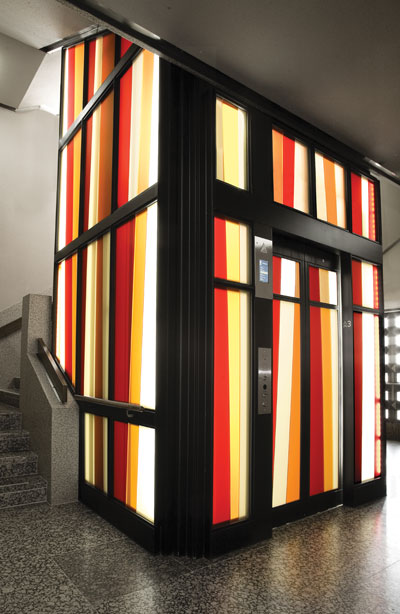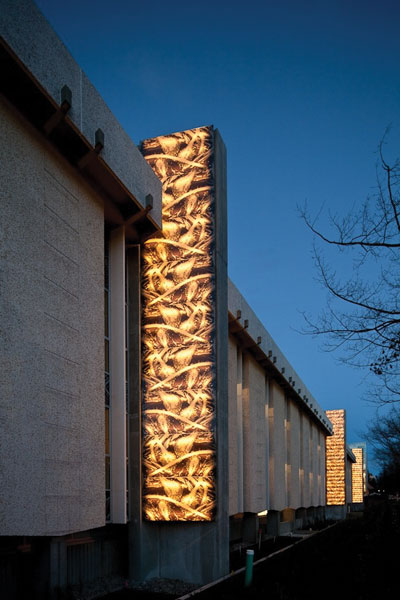
Features
Architectural design
Contracting
Decorative glass
‘New’ is the mantra of decorative glass.
June 10, 2011 By Rich Porayko
The specialty market has rebounded faster than other segments of the
glass industry with such projects as airports, hotels, office buildings,
labs, recreational facilities, schools and hospitals.
The specialty market has rebounded faster than other segments of the glass industry with such projects as airports, hotels, office buildings, labs, recreational facilities, schools and hospitals. Applications for decorative product are all over the map, while exciting new products are launched, including digitally printed product, glass that replicates stone and wood, and lamination featuring innovative fabrics and other materials. Esthetics aside, the common thread across the continent continues to be privacy, colour and daylighting.
 |
|
| St. Joseph’s Oratory in Montreal, using Starphire Satin 1 Face, tempered and laminated with coated interlayers. An acid etch removed the glare, providing full-colour rendering. Walker can provide acid-etch finishes on clear glass up to 100 by 144 inches. Photo courtesy of Walker Glass.
|
Reinvention
“Daylighting is important,” says Joel Berman, president of Joel Berman Glass Studios (JBGS). “Light transmission is a big deal.” Well known as cast glass innovators for over 25 years, JBGS are designers and manufacturers of architectural glass art in contemporary styles, with decorative products including direct-printed graphics, and back painted, recycled and laminated glass products featuring veneers and wire meshes. “Our products range from production to one-of-a-kind public art,” explains Berman. “For example, we are currently working on a glass iceberg that will be hung from the ceiling of the Winnipeg airport. We are also supplying an airport in Qatar which includes six water walls and various partitioning.”
According to Berman, many of the traditional applications for decorative glass are still strong. Hospitality applications tend to be shower doors or privacy partitions for restaurants and suites. Health-care facilities use partitions for privacy that are passive in design so they help people feel relaxed. Commercial projects typically include boardroom walls and sidelites. Airports often feature glass sculptures as public art.
Public art is an area of interest that is growing. “We just completed a whole city block of glass in a public park in New York from 29th to 30th street,” says Berman.
Berman says in the last few years there has also been a growing demand for decorative glass in horizontal surfaces, including back painted countertops, tables, canopies, floors and stairs, and that JBGS recently completed a glass sidewalk in New York. “As long as we are producing new and different designs, architects and designers gravitate to them.”
Colour that pops
“Coloured glass is in high demand. The ability to apply colour to glass is what designers dream about,” says Marc Deschamps, business development manager for Montreal-based acid etch glass and mirror manufacturer Walker Glass. “When acid etch is used on the first surface, it removes the glare and you can really get the full impact of any colour on subsequent surfaces.”
 |
|
| The glass concrete buttresses on the University of British Columbia biosciences building exterior feature digitally printed glass supplied by DSG Custom Glass and installed by John Peachy Associates.
|
“Architects are also trying to balance daylighting and glare,” says Deschamps. In addition to such applications as wall cladding, acid etch glass is often used in partitions, office enclosures, doors, conference rooms “or anywhere someone would want daylighting to blend with total, or partial, privacy.”
According to Deschamps, the product can be used in vision and non-vision spandrel areas for enhanced colour rendering due to the glare reduction. “Demand for acid etch in such exterior applications as the first surface of an insulated glass unit has been growing stronger,” he says. “An IG unit featuring acid etch on the first surface combined with a high performance soft-coat low-e on the third surface offers great performance.”
It is also possible to laminate a high-performance lite with acid etch on the first surface and the low-e coating on the interior number 4 surface. This would allow another coating on surface 5. Deschamps says, “Some of the avant garde architects out there will use a partial acid pattern to create such patterns as stripes and bands on the exterior surface of the curtain wall.”
Deschamps says acid etch is weather resistant because there is nothing else but glass. “We are simply polishing the glass surface and not adding any outside elements to the process,” he says. “We have also launched etched PPG Clarvista shower glass very recently. The product allows for privacy via the acid etch on the outside of the shower and corrosion resistance from the PPG Clarivista low-maintenance coating on the inside of the shower. Our customers have been telling us it is a winning combination.”
Direct print
“As architects and designers become aware that it is possible to print almost any type of image or illustration on the surface of glass, demand for digitally printed glass on the exterior has been increasing,” says Colin Thom, director of sales for Langley, B.C.-based DSG Custom Glass. DSG is a supplier of digitally printed glass products that feature photorealistic images the company claims will never fade, peel or crack. “Our product mix is mostly interior; however, exterior is growing,” says Thom. “The blend at this point is around 60 per cent interior and 40 per cent exterior.”
“DSG recently supplied a fitness and wellness centre in Montreal where the entire front facade is using direct-printed glass in the IG units,” says Thom. “Using frit in the exterior has a double benefit, because not only does frit provide a decorative element, it also reduces solar heat gain.”
According to Thom, tiling is also becoming increasingly popular in both interior and exterior applications. This is the process of creating a large image or series of images by printing a number of smaller individual lites to generate the overall vision.
Caveat emptor
“As the industry changes, on the positive side, there is more drive and need for specialty product,” says Bernard Lax, CEO of Los Angeles-based decorative glass pioneer Pulp Studio. “On the negative side, a lot of suppliers that have ventured into the business may not be prepared for some of the challenges specialty products bring in terms of understanding delivery, quality standards, pricing, sampling challenges and the conceptual element of working with a designer from the beginning. Many manufacturers spend more time trying to capitalize on the back end, picking up a job based on price with no investment in the design process.”
Lax continues, “What is really evolving in the industry is, there are many specialty products that are becoming commodity-based, such as back painted glass. These products, which have a big product range on the market, used to be mainly ceramic frit or silicone. Now we have back painted products that are more environmentally friendly, water-based coatings that are more open to customization and wider variety of colour.”
According to Lax, the biggest dilemma in the industry is that there are a lot of people who still don’t understand the dynamic differences between these coatings, and the challenges or benefits between one type of product and another. “What is lacking in the industry is the educational aspect of the business. The contract glaziers aren’t out there trying to understand the differences and nuances of the different products and the industry is doing nothing to educate them.”
To the detriment of everyone in the business, decorative products, which are among the most expensive products in the glass industry, have typically been purchased from the lowest bidder. Lax says, “It amazes me that companies still buy based on a promise and not based on research or fact. You end up with a company buying tens or hundreds of thousands of dollars worth of glass from resources that may or may not be viable vendors and not knowing some of the basic differences.”
“I rarely have any glass company ask me about the warranty,” says Lax. “People are always in a hurry to bid a job so they go with the lowest number and it doesn’t always pan out to be a successful project. There are jobs out there with the wrong product installed that have poor performance, which has an impact on the entire product range. It comes down to buying the right product. And that lack of education in the industry is the basis of people making good or bad decisions. Whether it is graphic, laminated or back painted product, it comes down to the decision maker who is buying the glass and what that person knows about the product and the selection of the vendor.”
It is obvious that graphic imaging is becoming more popular and with it comes the issue of colour sustainability on the exterior. “There are people that don’t understand what the sustainability issues are. The first questions they should be asking before anything else are not about the price but about sunlight testing and warranty information on the colours. Yet there are many installers that are buying product and never asking about warranty or sustainability. It is happening slowly. As the industry becomes more aware, we are seeing more and more educated buyers asking questions.”
Architects and developers are always looking to gain energy benefits, however they ultimately want a building that also looks good. “Some of the biggest decorative trends we’ve been following are for products outside the building that offer solar benefits such as shading coefficient and still have decorative elements such as sunshades,” Lax explains.
Pulp has recently launched a new product Lax describes as including different decorative elements suspended inside an insulated glass unit that minimizes the need for having high-maintenance sunscreens on the exterior of a building. “If you are a true decorative glass producer, every week is a different product. The key to being successful is to be able to make any product in any given week and carry the inventory of the components you need to do so,” says Lax. “There are opportunistic companies that jump in the market for certain job specific products that they don’t stock all the time. The true producers of these products are usually carrying inventories and can deliver a certain amount of that product any given week.” •
Rich Porayko is a professional writer and founding partner of Construction Creative, a marketing and communications company located in Metro Vancouver, B.C. richp@constructioncreative.com
Print this page
Leave a Reply